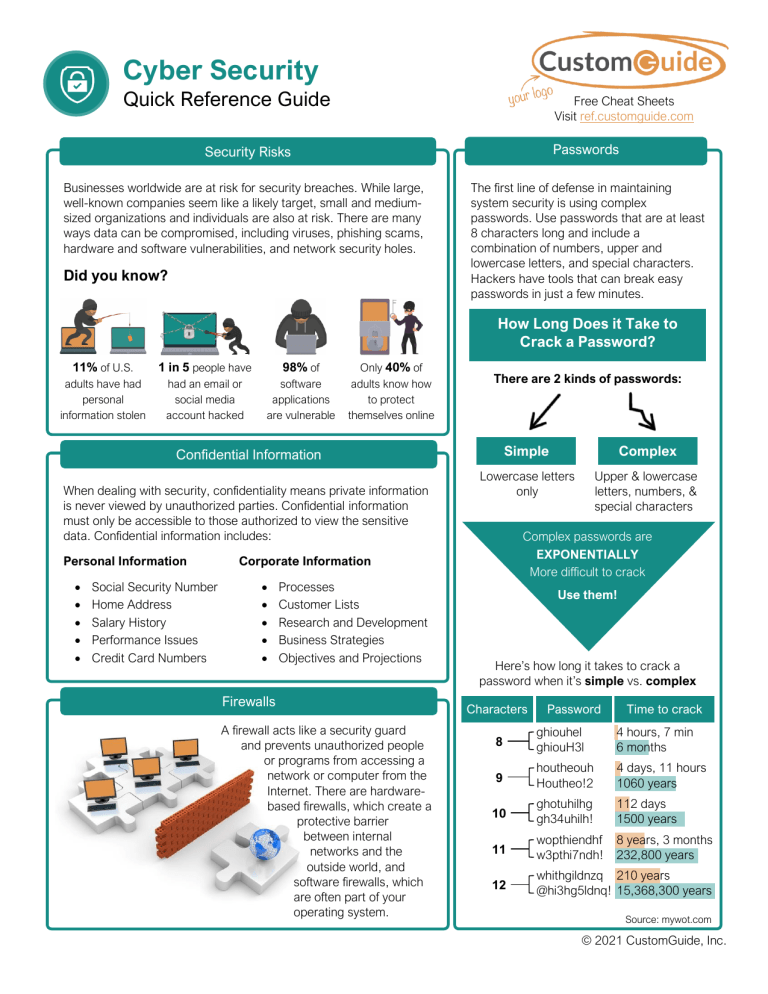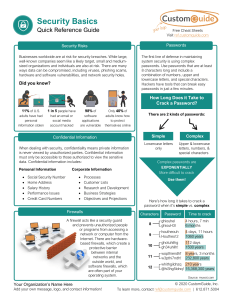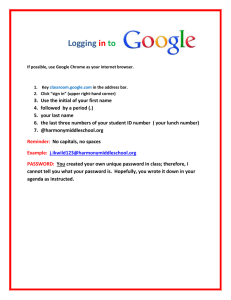
Cyber Security Quick Reference Guide Free Cheat Sheets Visit ref.customguide.com Passwords Security Risks Businesses worldwide are at risk for security breaches. While large, well-known companies seem like a likely target, small and mediumsized organizations and individuals are also at risk. There are many ways data can be compromised, including viruses, phishing scams, hardware and software vulnerabilities, and network security holes. Did you know? The first line of defense in maintaining system security is using complex passwords. Use passwords that are at least 8 characters long and include a combination of numbers, upper and lowercase letters, and special characters. Hackers have tools that can break easy passwords in just a few minutes. How Long Does it Take to Crack a Password? 11% of U.S. adults have had personal information stolen 1 in 5 people have had an email or social media account hacked 98% of software applications are vulnerable Only 40% of adults know how to protect themselves online There are 2 kinds of passwords: Simple Complex Lowercase letters only Upper & lowercase letters, numbers, & special characters Confidential Information When dealing with security, confidentiality means private information is never viewed by unauthorized parties. Confidential information must only be accessible to those authorized to view the sensitive data. Confidential information includes: Personal Information • • • • • Social Security Number Home Address Salary History Performance Issues Credit Card Numbers Complex passwords are EXPONENTIALLY More difficult to crack Corporate Information • • • • • Processes Customer Lists Research and Development Business Strategies Objectives and Projections Firewalls A firewall acts like a security guard and prevents unauthorized people or programs from accessing a network or computer from the Internet. There are hardwarebased firewalls, which create a protective barrier between internal networks and the outside world, and software firewalls, which are often part of your operating system. Use them! Here’s how long it takes to crack a password when it’s simple vs. complex Characters Password Time to crack 8 ghiouhel ghiouH3l 4 hours, 7 min 6 months 9 houtheouh Houtheo!2 4 days, 11 hours 1060 years 10 ghotuhilhg gh34uhilh! 112 days 1500 years 11 wopthiendhf w3pthi7ndh! 8 years, 3 months 232,800 years 12 whithgildnzq 210 years @hi3hg5ldnq! 15,368,300 years ! Source: mywot.com © 2021 CustomGuide, Inc. Malware Malware is short for "malicious software." It is written to infect the host computer. Common types of malware include: Replicating computer program that infects computers Hijacks your computer or browser and displays annoying advertisements Secretly tracks your internet activities and information Online Browsing Network Security Browsers communicate to websites with a protocol called HTTP, which stands for Hyper Text Transfer Protocol. HTTPS is the secure version of HTTP. Websites that use HTTPS encrypt all communication between your browser and the site. Secure sites have an indicator, like a padlock, in the address bar to show the site is secure. You should always ensure security when logging in or transferring confidential information. Malicious program that tries to trick you into running it Sites without HTTPS are not secure and should never be used when dealing with personal data. If you are simply reading an article or checking the weather, HTTP is acceptable. • Use Wi-Fi password security and change the default password • Set permissions for shared files • Only connect to known, secure public Wi-Fi and ensure HTTPS-enabled sites are used for sensitive data • Keep your operating system updated • Perform regular security checks • Browse smart! Email and Phishing A phishing email tries to trick consumers into providing confidential data to steal money or information. These emails appear to be from a credible source, such as a bank, government entity, or service provider. Here are some things to look for in a phishing email: Grammatical Errors Sender’s Address Spelling mistakes and poor grammar The address should be correlated with the sender Generic References Immediate Action Not being addressed by your name Hover Link Always check where links lead before clicking Beware of anything that calls for urgent action Attachments Never open an attachment you aren’t expecting © 2021 CustomGuide, Inc. Get More Free Quick References! Visit ref.customguide.com to download. Microsoft Google Software Business Skills Access Gmail Adobe Captivate Business Writing Excel Google Chrome Computer Basics Cyber Security Office 365 Google Classroom macOS Email Etiquette OneNote Google Docs QuickBooks Manage Meetings Outlook Google Drive Salesforce Presentations PowerPoint Google Meet Slack SMART Goals Teams Google Sheets Storyline Time Management Windows Google Slides Zoom Word Google Workspace + more, including Spanish versions Everything you need to provide amazing training View Demo Interactive Online Learning Skill Assessments Customizable Courseware Over 3,000 Organizations Rely on CustomGuide Request a Free Trial: info@customguide.com 612.871.5004


